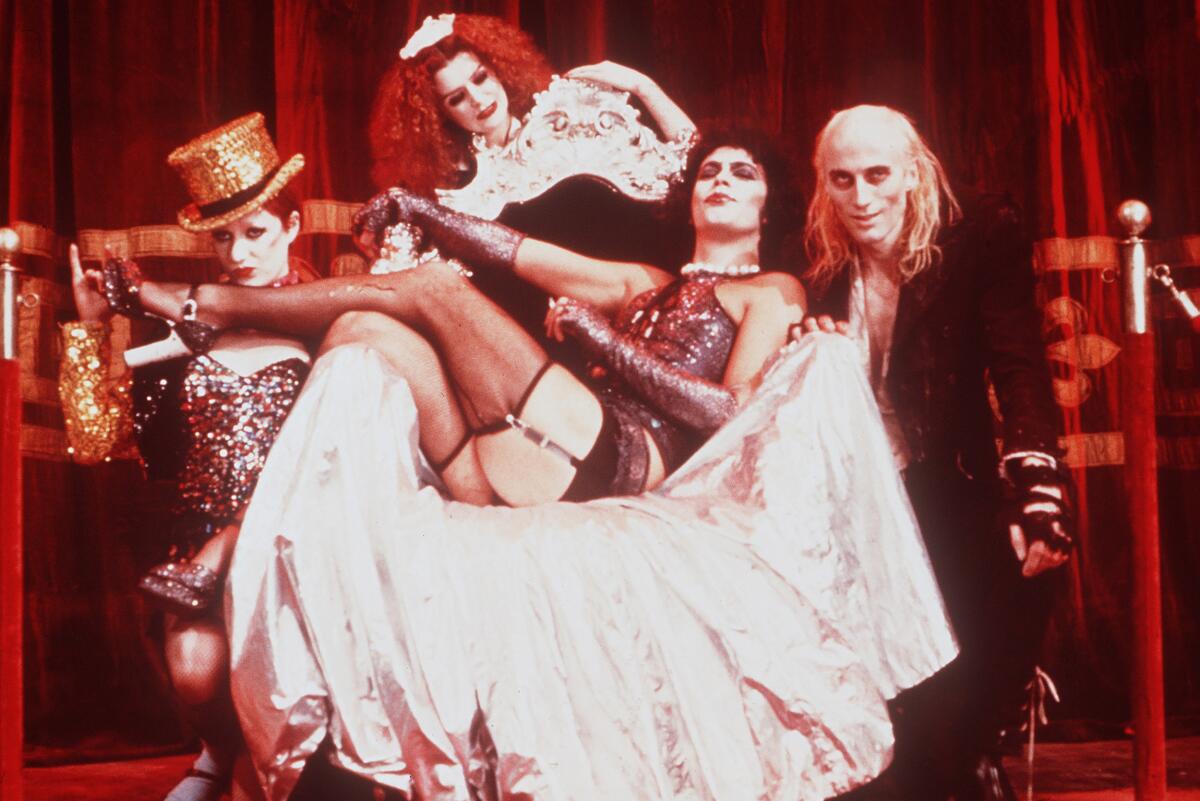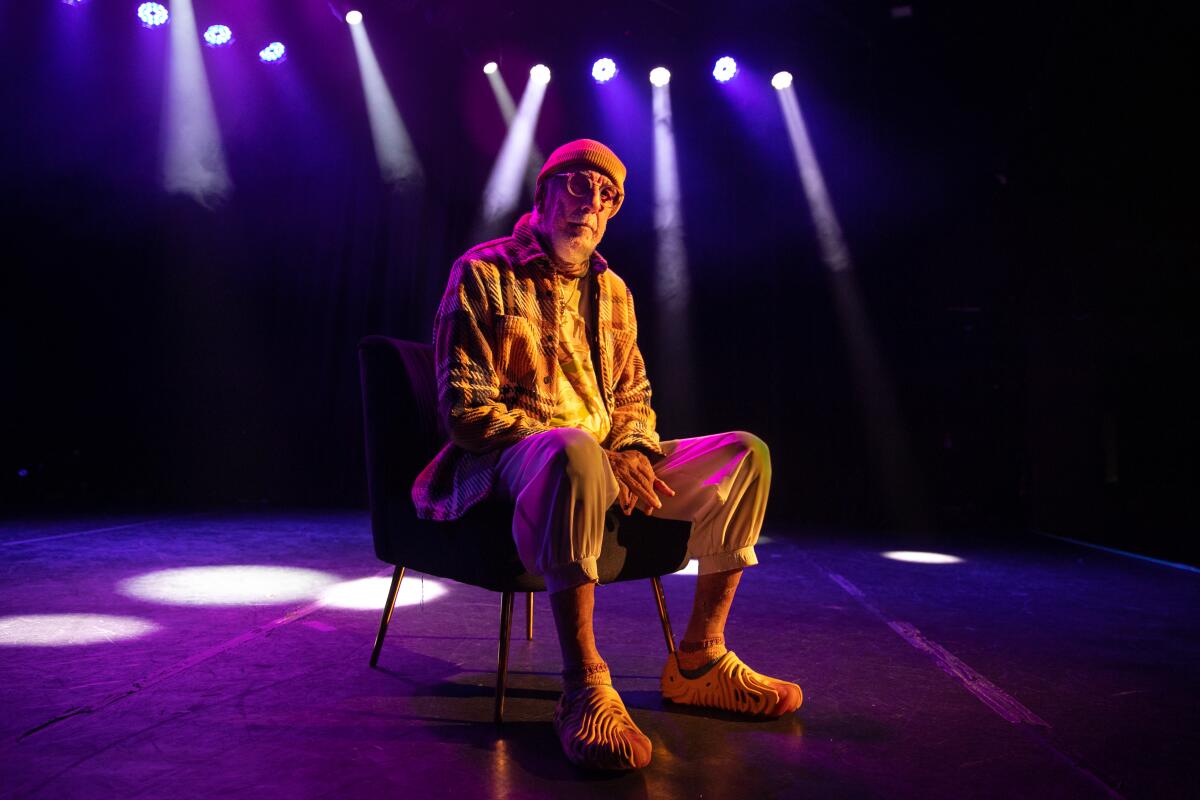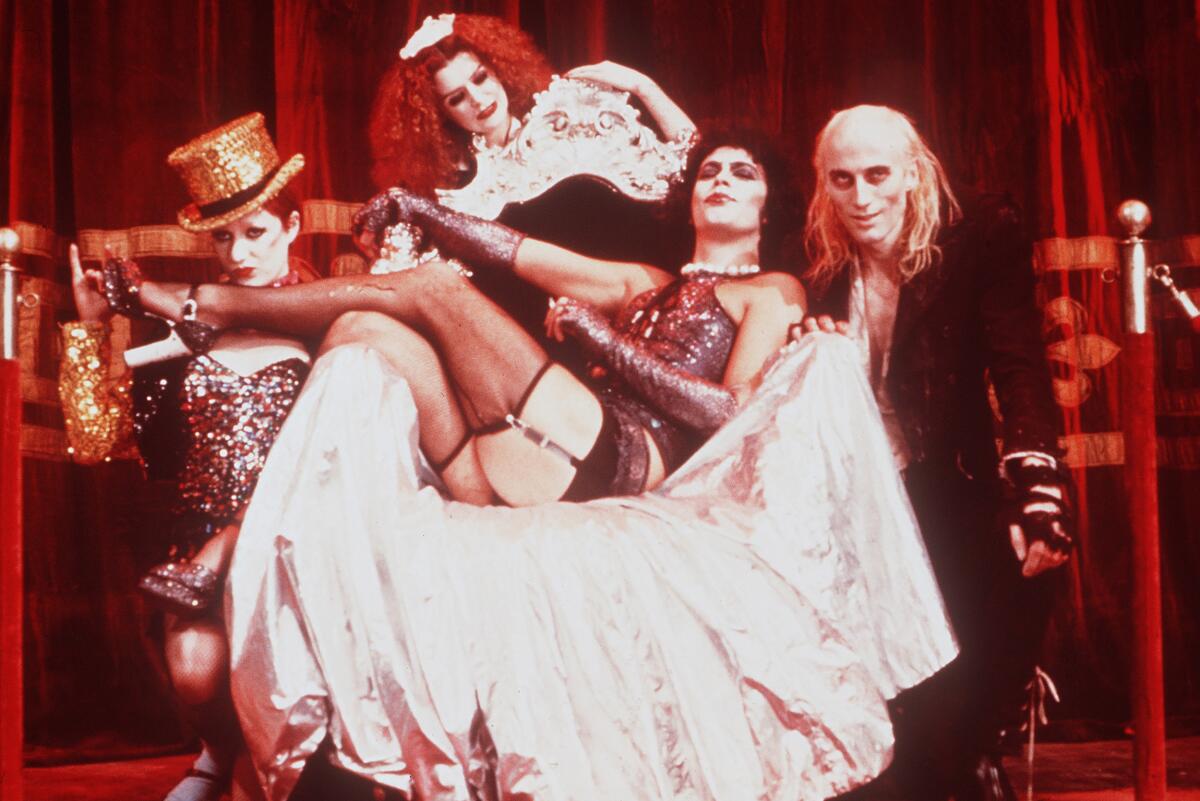Tim Curry revisits the Roxy Theatre and ‘Rocky Horror,’ turning 50
The old stage at West Hollywood’s Roxy Theatre looks as small as ever to Tim Curry. Back in 1974, the actor spent nearly a year strutting across its boards in fishnets and a snug corset as Dr. Frank-N-Furter, the flamboyant, sexually ravenous mad scientist of the musical comedy “The Rocky Horror Show.”
Witnesses to that run of performances still marvel at the spectacle of Curry’s nightly entrance, as he marched from the lobby on a long catwalk, his high heels at eye level with the audience. He would then cast aside his Dracula cape to sing a personal theme song, “Sweet Transvestite.”
“It’s actually really nice to be here because it was another home for me,” says Curry, 79, looking up at the empty stage inside the Sunset Strip nightclub. “It became my stomping ground. I had to appear as though I owned it — and I kind of did.”
At the end of that same year, Curry was back home in England to shoot the feature film version, “The Rocky Horror Picture Show,” a rock ’n’ roll send-up of old sci-fi and horror B-movies that became both a cult classic and a vibrant symbol for sexual freedom. It is the original midnight movie and is now being feted around the world for its 50th anniversary with a second life as the longest continuous theatrical release in cinema history.

Tim Curry, center, as Frank-N-Furter in 1975’s “The Rocky Horror Picture Show.”
(John Jay Photo / Disney)
The role changed Curry’s career forever, and he will be part of some of those celebrations, beginning with a screening of a newly restored 4K version of the film, along with a panel Q&A, at the Academy Museum on Friday.
At the time of the film’s original release in 1975, it tapped into a cultural zeitgeist that mixed glamour and androgyny, akin to the era’s glam-rock movement led by David Bowie. “The Rocky Horror Picture Show” ultimately found a cult of fans who gathered for weekly midnight screenings in costume as the movie’s outlandish characters, performing as a “shadow cast” in harmony with the film onscreen.
“It was part of the sexual revolution, really,” says Curry. “Experiment was in the air and it was palpable. I gave them permission to be who they discovered they wanted to be. I’m proud of that.”
Since a stroke in 2012, the actor has been in a wheelchair and most of his work has been in voiceover. He did appear on camera in a 2016 remake of “Rocky Horror” for television, this time as the criminologist. But it was as the lascivious, self-confident Frank-N-Furter that Curry made history.
On this afternoon, he is dressed in black, auburn hair slicked back. In the Roxy’s lobby is a portrait of Curry in character as the mad doctor in pearls. It was a role he originated in London, on the tiny stage upstairs at the Royal Court Theatre, where it first became an underground sensation.
“Even for the time, there was a lot of courage that went into that performance,” remembers Jim Sharman, who directed Curry in the original stage productions in London and Los Angeles and then onscreen. “Tim himself was actually a kind of quiet intellectual offstage, but onstage he really knew how to let it rip.”

Curry, center, in “The Rocky Horror Picture Show.”
(Disney)
With a story and songs written by actor Richard O’Brien, who also played the skeletal, sarcastic Riff-Raff, “Rocky Horror” begins with a young couple caught in a rainstorm who approach a mysterious castle in search of shelter and a phone.
Played by then-unknowns Susan Sarandon and Barry Bostwick, the couple find Frank-N-Furter is hosting a convention of partying aliens in formalwear from the planet Transsexual in the galaxy Transylvania.
The mad doctor is also anxious to show off his latest experiment, the creation of a perfectly formed male, a personal plaything of chiseled muscles and blond hair, as he sings “I Can Make You A Man.” The scene leaves an impression.
“He takes no prisoners — it’s his world and you just happen to live in it,” Curry says with a smile of his Frank-N-Furter. “He doesn’t leave much air in the room. And I enjoyed that because it was so not like me, really.”
Notably, the film shares a 50-year anniversary with “Jaws,” and Curry remembers someone at 20th Century Fox placing newspaper ads that year for “Rocky Horror” with the film’s glossy red lips image and words promising, “A different set of jaws.”
“Jaws,” of course, was a record-breaking summer blockbuster, but as the longest-running theatrical release of all time, “Rocky Horror” really has no competition in terms of impact. It helped establish a culture for midnight movies in open-ended rotation, from David Lynch’s “Eraserhead” to Paul Verhoeven’s “Showgirls.”
At the customary hour of midnight, the restored 4K film will be premiering across the country this weekend, with special screenings and Q&As on Oct. 4 at Hollywood Forever Cemetery and Oct. 15 at the Grammy Museum. The film will then be rereleased on Blu-ray on Oct. 7, with a reissue of the official soundtrack album on Oct. 10.
Also landing in time for the celebration is a new documentary, “Strange Journey: The Story of Rocky Horror,” directed by Linus O’Brien, son of “Rocky Horror” author and composer Richard O’Brien. The 90-minute film explores the making of the movie, the original stage musical and the decades of fan culture that followed.
“When a work of art survives this long, it’s working on many different levels,” says the younger O’Brien, who was a toddler on the set. “You want to live in that house and have those naughty experiences. [People] will be talking about it long after we’re all dead.”
The “Rocky Horror” journey from underground theater to feature film began after Los Angeles music impresario Lou Adler saw the show during a trip to London. Known as a manager and record producer (Carole King’s “Tapestry”), Adler was shaken from his jet lag, instantly recognizing “Rocky Horror” as a potential attraction for his recently opened L.A. club, the Roxy. Within two days, Adler signed a deal to host its U.S. premiere.
At the Roxy, the show was an immediate sensation, fueled by Curry’s wildly charismatic performance. Opening night brought out a crowd that included Jack Nicholson, John Lennon and Mick Jagger. L.A. Times theater critic Dan Sullivan compared Curry to various Hollywood grande dames (Joan Crawford and Bette Davis, among them).
“It was one of the great parties of all time,” Adler recalls during a video call from his home in Malibu. “The acceptance was unbelievable.”
Talk of turning the stage musical into a movie soon followed and a deal was made with 20th Century Fox, with producers Adler and Michael White guaranteeing delivery on a modest budget of about $1 million.
“I don’t know if 20th Century Fox ever understood the film,” Sharman says with a laugh, in a video call from Australia. “They might’ve been relieved that it was going on a low budget and being made on somebody’s lunch money.”
It was the first feature film for many of them. But Adler and White insisted on keeping the stage musical’s creative team together, including Sharman, costume designer Sue Blane and production designer Brian Thomson. With Curry firmly in the lead role, most of the cast members were drawn from the London production. Joining them were American actors Sarandon, Bostwick and singer Meat Loaf.
“I adored her,” Curry says of Sarandon. “She was a witty girl and so beautiful, and a real actress, I thought. You could tell that she had something.”
He also became friends with Meat Loaf, who appeared in the small but impactful role of Eddie, bursting out of a freezer on a motorcycle long enough to sing the manic “Hot Patootie, Bless My Soul.” In 1981, Curry hosted “Saturday Night Live” and appeared with Meat Loaf in a skit that had the actors selling “Rocky Horror” memorabilia. (Curry is still irritated by that one: “Dreadful.”)

Lou Adler, photographed at the Roxy in West Hollywood in 2023.
(Jason Armond / Los Angeles Times)
“When the movie was a definite thing, there were several big stars who wanted to play the part,” Curry remembers. “Mick Jagger wanted to play it and he would’ve done a great job if you saw ‘Performance.’ But [director Sharman] said he wanted me to do it. I don’t think the studio was happy that he turned down Mick.”
Though Sharman was a very experienced stage director, he had made only one previous film, a 16mm feature called “Shirley Thompson vs. the Aliens.” For “Rocky Horror,” he says he was aiming for “a dark version of ‘The Wizard of Oz.’” He was also inspired by old B-movies and German Expressionism along with lessons learned from the stage. Interior scenes were shot at the old Hammer horror films’ Bray Studios just outside London.
“The reason we don’t have great anecdotes from the shoot is we didn’t have time for anecdotes,” adds Sharman. “It was shot in five weeks.”
Bostwick, appearing in one of his first film roles, remembers, “It felt like a very low-budget but colorful, bright and inspiring musical. You knew from the moment you were around the sets and costumes and lighting and makeup and camera people that they were at the top of their game.”
“The Rocky Horror Picture Show” evolved in some subtle but meaningful ways in its transition from the stage. For the live performances, Curry did his own makeup. “In the theater, I made it look a lot more amateur, deliberately, like he wasn’t good at it but was making a brave attempt and didn’t care much,” Curry says with a laugh. “In the play, it was just a lot trashier.”
For the film, French makeup artist Pierre La Roche was recruited to refine Frank-N-Furter’s exterior. La Roche had previously worked with Bowie during the Ziggy Stardust era.
“He was indeed very French,” says Curry, campily. “He was brilliant.”
An early sign of the challenges the movie would face arrived at an early screening of the completed film for Fox executives. Curry was there with Adler. “You could touch the silence at the end,” recalls Curry. “It wasn’t a very alive audience. There was really no reaction at all.”
Fox also hosted a test screening in Santa Barbara. The audience was a local mix of retirees and university students, and many of the older filmgoers began heading for the exit, until the theater was nearly empty.
But as Adler and a young Fox executive named Tim Deegan sat on the curb outside, they also met young people who were excited about the film. Adler credits Deegan for finding the “Rocky Horror” audience in an unexpected place: indie theaters at midnight.
Its second life began at the Waverly Theater in New York, where it began evolving into a happening that was both a movie and a theatrical experience. At the time, Curry happened to live within walking distance of the Waverly.
“It was a sort of guaranteed party,” he says of any potential moviegoer. “And if he didn’t bring a date, he could perhaps find one.”
On a recent weekend at the Nuart Theater in West L.A., barely five miles away from the Roxy, it’s approaching midnight and the lobby is filled with fans and volunteer shadow performers in “Rocky Horror” drag. Appearing as Frank-N-Furter is Kohlton Rippee, 32, already in his heels and makeup.
Like many here, he sees the film as both an outlet and a connection to a found family — a way “to see aspects of themselves represented in ways that they don’t see from traditional media. It’s like, ‘Oh, I can see myself in this and find this weird community to be around.’”
Bostwick first heard of the film’s second life from others and word trickled in that his every appearance onscreen was met with an affectionate callback from the crowd: “Ass—!” He didn’t see the phenomenon himself until later at the Tiffany Theater on Sunset.
“What do they say, that Disneyland is the happiest place on Earth? I’ve always thought that a Friday and Saturday night at a theater at midnight was the happiest place on Earth,” the actor says of the many raucous screenings he’s witnessed. “Everybody was just having a ball.”
After Walt Disney Co.‘s 2019 acquisition of 20th Century Fox, it turned the House of Mouse into the unlikely steward of “Rocky Horror.” Back in 1975, nothing could have been further from the Disney brand than a rock ’n’ roll musical about a cross-dressing scientist. That year, Disney released “The Apple Dumpling Gang.”
“I guess Walt is kind of revolving in his grave,” Curry jokes.
Even so, Adler says Disney has been a good partner on “Rocky Horror” and is supporting the multiple official anniversary events. “Walt was a breakthrough guy,” the producer notes. “He broke through and made a mouse a hero. So, in a way, he had his own Frank-N-Furter.”
